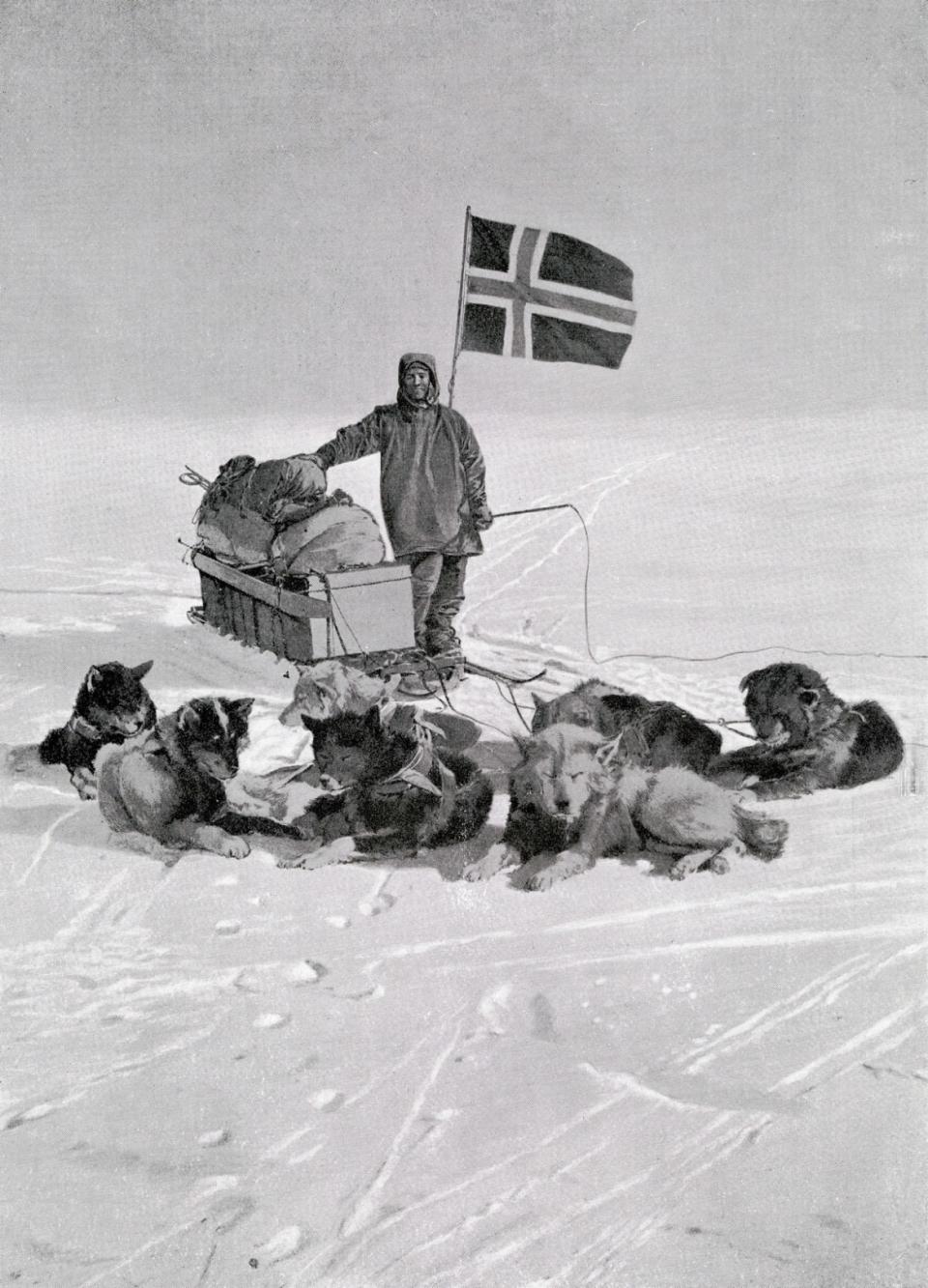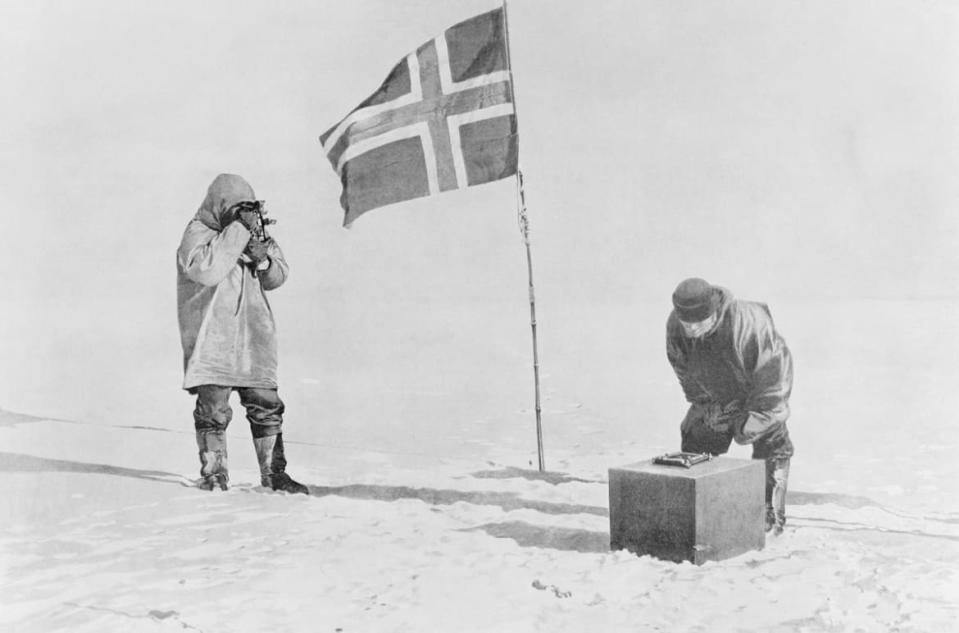Roald Amundsen Didn’t Reach the Poles by Being a Nice Guy

- Oops!Something went wrong.Please try again later.
- Oops!Something went wrong.Please try again later.
The great polar explorer Roald Amundsen stood by himself on the frozen Arctic shore, staring into the distance. He was fifty-three years old—but looked seventy-five—and bankrupt.
On the ice in front of him, the men of the Amundsen-Ellsworth polar flight had broken open the large, long wooden crates that contained the two flying boats. Now their job was to reassemble the craft, laboring in subzero temperatures with little more than a block and tackle, the coal miners from the Kings Bay Mine ready to provide the muscle power when they needed it. Nearby, a journalist and photographer recorded their every move.
Beautiful white mountains penned Amundsen in on three sides. Their glaciers glinted in the May sunlight. For a moment, the twenty-two houses of the mining village looked more like holiday cottages.
“The Arctic smiles now, but behind the silent hills is death,” another journalist would later write, and he would be proved right.
Out in the bay, the sea was filled with great chunks of ice. Beyond stretched the endless, empty ice pack, known as the Arctic desert, a huge empty hole on the map of the world roughly the size of Canada that had never before been explored. Somewhere on the other side was Alaska.
How Do You Win the Race to the North Pole? You Cheat.
Men quickly became invisible from the air in this brilliant white landscape. If their primitive flying machines descended and they couldn’t get back up, then there was almost no likelihood that they would be found. Even if someone knew where they were, there would be a good chance that they had strayed beyond the range of their would-be rescuers, particularly if they were the crew of a dirigible. These lighter-than-air craft could stay in the air for days at a time and fly much farther than their fixed-wing aircraft rivals.
The sea ice that makes up the ice pack could be many feet thick, and then suddenly only half an inch thick, ready to plunge the unwary—or too hasty—explorer into the frozen water underneath. Nighttime might not bring much relief to the explorer either. The cracking and creaking of the ice could keep many a man from sleeping, no matter how exhausted they were, their bodies braced for the moment when they—and their tent—might suddenly be plunged into the icy water below. Then there was the disorientation. When they woke up, they could be as many as twenty miles from where they had gone to sleep.
To crash out there would in all likelihood mean death, though surprisingly this didn’t seem to bother the average adventurer. This was their choice: to be noticed, to be remembered. Glory and fame were what most of them had come there for—and one way or another, they were determined to get it.
Welcome to the Svalbard archipelago.
To locate these mountainous islands on a map, you first have to find Scotland, then trace your finger up past Iceland, Norway, and Greenland. From the map, it looks as though you could swim—or even march—from the islands to Greenland, Canada, Alaska, or Russia. But of course you can’t: the distances are still vast, the passages grim and unwelcoming.
All Amundsen needed, he kept telling himself as he stood out there, was one last big paycheck.
It was 1925: twenty years since the Norwegian had become the first man to successfully navigate his way through the Northwest Passage, the sea route from the Arctic to the Pacific Ocean. Sir John Franklin and his 128 men had disappeared around sixty years previously to this trying to make the same journey in two old warships.* Amundsen had done it slowly with six men over three years in an old fishing boat. That journey had been surpassed six years later when Amundsen beat the British hero Robert Falcon Scott to the South Pole in 1911. Scott and his four companions died on their way back from the pole. Amundsen had arrived first at the South Pole after claiming to be heading to the Arctic Ocean. He had kept his “coup” secret from most of the crew on the voyage from Norway to Portugal, the politicians funding him (whom he detested after they had rejected his plea for more money), the government that owned his ship, and the king of Norway himself. He had even betrayed the trust of his Norwegian mentor, Fridtjof Nansen, who had his eye on the same prize. The fate of others was not much of a concern to Amundsen.

Captain Roald Amundsen at the South pole under the Norwegian flag, 1912
Amundsen’s decision to use huskies, which were bred for these conditions, on his race to the South Pole was the difference between his life and Scott’s death. The Englishman’s choice of ponies and gasoline engine tractors, which were untested in such extreme conditions, had condemned him to second place—and, ultimately, him and his men to their deaths. Yet Amundsen had refused to see Scott when the Brit visited Norway to watch a demonstration of the mechanical tractors prior to his journey to the pole. The Norwegian had kept his doubts to himself. Amundsen didn’t get to be a world-famous Arctic explorer by being “nice.”
The Norwegian was also savvier than his English rival. Both Frederick Cook’s claim to have reached the North Pole on foot in April 1908 and Robert Peary’s a year later were swiftly doubted at the time. Despite the rather dubious support of more than fifty psychics, the question mark over Cook’s claim was so strong that he was widely seen as a fraud, and his career was ruined. The scandals that surrounded the “achievements” of these men then threatened to taint the claim of every explorer, and Amundsen was quick to realize this. When he set off for the South Pole, he made sure he would not suffer the same fate as these two men. Amundsen listened to the experts who explained why Cook’s and Peary’s navigation left their achievements open to doubt. Conversely, Scott ignored their advice. Amundsen then used the latest navigational know-how to make sure accurate records of the route of his expedition were regularly taken and kept as evidence that he had reached the South Pole. Scott used the traditional methods, which were slower, exhausting in such extreme conditions, and less accurate. He paid the price for his decision.
When Amundsen and his men arrived at the South Pole in December 1911, they didn’t sing a patriotic anthem, give a speech, or indulge in any other unmanly histrionics. Instead, the Norwegians simply read a passage from the nineteenth-century version of the medieval Saga of Fridtjof, a celebration of traditional, heroic masculinity, which had been incredibly popular when it was published but was now fading from memory.

Amundsen Expedition: Proving themselves at the South Pole by use of sextant and artificial horizon. Captain Roald Amundsen discovered South Pole on December 14-17, 1911.
However, the challenges Amundsen faced didn’t end when he sailed back home. A life spent at the extremes of the world, in the close company of men, and shifting between the rooms of luxury hotels and the snow and ice of both poles, had not been conducive to any hopes that Amundsen may have had of marriage. Instead, he satisfied himself with affairs with several married women, the wives of powerful men in the towns and cities he passed through. Indeed, Amundsen wasn’t alone in this. Many of his fellow explorers also struggled to settle down. In the absence of any children of his own, Amundsen had adopted two Inuit girls a few years earlier, in spite of the gossips who wondered who their real father was, but controversially sent them back to Siberia when he faced bankruptcy.
* In 2014 and 2016, the wrecks of HMS Erebus and Terror were finally discovered. While the fate of the survivors is still clouded in mystery, it is now thought that the expedition had managed to explore the unexplored part of the Northwest Passage. However, the ships and their ghosts have one more duty to perform to their country: The shipwrecks are helping Canada reinforce its claim to the Arctic in the face of competition from countries like Russia.
From N-4 Down by Mark Piesing. Copyright © 2021 by Mark Piesing. Reprinted by permission of Custom House, an imprint of HarperCollins Publishers.
Get our top stories in your inbox every day. Sign up now!
Daily Beast Membership: Beast Inside goes deeper on the stories that matter to you. Learn more.

